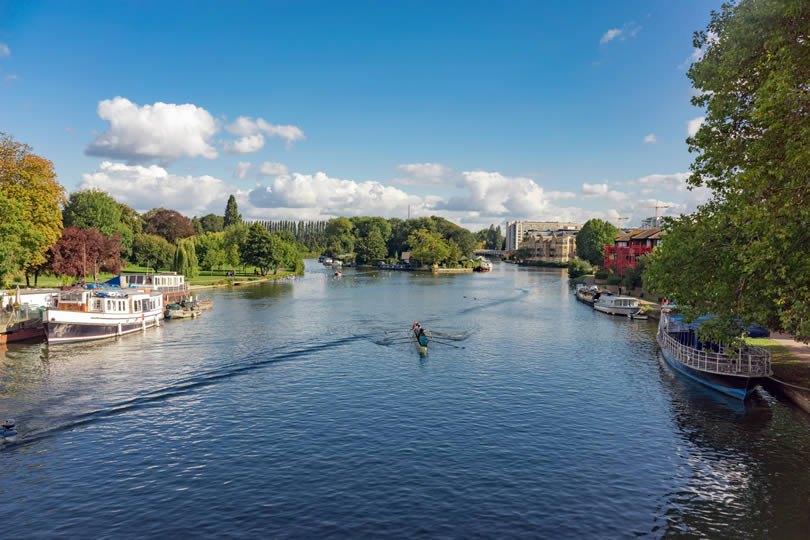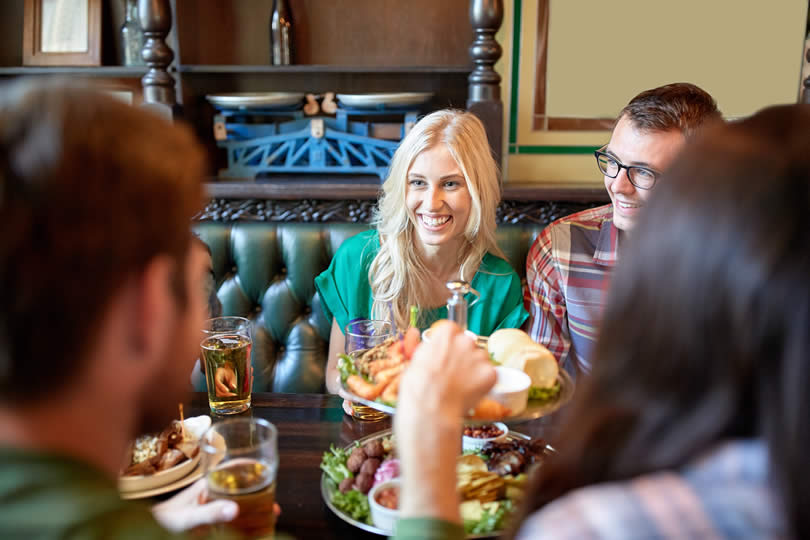Visiting Reading on a Budget
Reading Berkshire UK budget travel guide
Reading is a borough town situated in the county of Berkshire, southern England. Although the town is less well-known than nearby London, Reading is the location of significant historical events in English history, most notably the Battle of Reading in 871 when Alfred the Great fought the Danes.
Today, it is a town thriving with industry and culture, and filled with attractions to visit and things to do. Its location on the crossing of the River Thames with the River Kennet renders it a place of great beauty. In addition to the waterways, the town is located at the junction of several major motorways, creating cheap holiday and excursion opportunities for visitors. With careful planning and budgeting, a trip to Reading need not cost too much.
Travel to Reading
The residents of southern England can travel to Reading by train and coach, motorcar, bus and bicycle. Visitors from outside Britain will find many budget flights from world cities to Heathrow airport, about 40 km away and a journey of around forty minutes by road.
RailAir, an express bus service, links Heathrow airport to the town. A return ticket for this service costs between £8 and £49, depending on the ages of the passengers and the time of travel.
Motoring
Reading’s location at the junction of the old Bath road from London to Bristol and to other important towns in the West Country means that no fewer than five main motorways, including the A33 and the A327, serve it.
Air passengers can hire a car or taxi at Heathrow, while British residents can travel quickly and easily to the town in a private or hired car, or taxi.
Train travel

Three major rail companies serve Reading railway station, with pedestrian access from Blagrave Street. Daily, trains arrive from cities like Newport and Cardiff in Wales, and from towns in the west counties.
Trains also connect Reading with northern towns like Manchester and Newcastle, southern towns like Bournemouth and Southampton and of course, London and its surrounding districts.
Visitors travelling through Heathrow can take the Heathrow Connect service to Paddington and change for Reading at Hayes & Harlington station, a trip that costs between £19 and £26.
Coach travel
National Express coaches arrive at the Mereoak Park & Ride facility on the Basingstoke Road. The facility offers parking space for cars, open from early on Monday morning to late Saturday evening. A fee of 50p is payable per car daily, which contributes to the cost of a bus ticket.
Getting around Reading
Several bus companies operate within the town, providing access to all places of interest and at a low cost. For example, a Reading Bus flat flare is £1.90. A daily ticket for the town is £4 and a weekly ticket is £15.
Prices are lower for passengers under 18. Cyclists are welcome in the town and the area borough council provides cycle maps for people wishing to travel on two wheels.
What to do in Reading
The borough’s most famous annual event is the Reading Festival, which takes place across the last Friday, Saturday and Sunday in August. The Festival features many well-known rock groups. Tickets are in high demand and interested parties should book well in advance. The organisers also sell weekend camping plans.
In addition to this annual rock music venue, the town is amply filled with museums, theatres and historical buildings. Because of its Thames Valley location, no fewer than five nature reserves are within reach of the town.

The nature reserves
Take the bus from Reading to nearby Caversham where you will find Clayfield Copse, an area of woodland and meadow filled with wild flowers. If you wish, you can follow a sculptural trail.
Alternatively, travel to Tilehurst to visit McIlroy Park. This area of natural loveliness comprises woodland and grassland on a steep hillside. You can follow an intriguing ancient path through the woods, which touches on old clay pits and on a Saxon mound.
Nearby is Round Copse, a haven for birdwatchers, where you can observe many species, including the Red Kite and the Willow Warbler. Lousehill Copse is a little further away. It has interesting reserves of flora and fauna, and includes a pond.
The Museum of English Rural Life
If you wish to pursue indoor attractions, take the bus to the University of Reading campus, which is located on London Road, south-east of the town. Among its buildings you will find the Museum of English Rural Life.

The collections at this museum chart the changes to country life that have taken place in England since World War Two. Gallery exhibits include old Wellington boots, a wagon walk and displays of farm machinery that demonstrate the ongoing developments in rural technology. The museum owns photo and film archives, and a library of books and journals. Visitors may access the library on production of ID.
Admission to this museum is free, although charges are in place for certain events. The museum and garden are open Tuesday to Friday, 9 am to 5 pm. On Saturday and Sunday, it opens from 10 am to 4 pm, and on the last Thursday of every month, the attractions stay open until 9 pm. The museum shop and café stay open in accordance with these times. However, the attractions are not open on certain university closure days, on Bank holidays, Christmas Day and Easter Sunday. Check before you visit.
The Reading Museum
It is advisable to visit the Reading Museum, located on Blagrave Street, north-west of the town, in the afternoon. Its galleries tend to fill with school groups in the morning and when you visit the museum, you will find out why.
Its galleries abound with exhibits that relate to excavation of the Roman town of Silchester. In addition, it displays a full-sized replica of the Bayeux Tapestry and has a section devoted to the history of Huntley & Palmer, the town’s famous biscuit-manufacturing firm. The Museum is open from Tuesday to Saturday, 10 am to 4 pm. Entrance is free to members of the public.
The Abbey Gateway
In 1121, Henry 1 founded Reading Abbey and made the town a significant ecclesiastical centre. Not far from Reading Museum, you will find the Abbey ruins, which are closed to the public until 2019 because of restoration work.
However, you can still see the Abbey Gateway, which survived the dissolution of the monasteries by Henry VIII. The Gateway has been in use down through the centuries, most notably as the Abbey Boarding School, which the great English author Jane Austen attended for two years. In the 1860’s, the Victorian architect George Gilbert Scott restored it. Contemplate its ornate façade for some minutes before turning down Abbot’s Walk to the entrance of Forbury Gardens.
Forbury Gardens
You may want to stop at the new kiosk for a tea or coffee as you enter the Gardens. Refreshed, head for inner Forbury. Your route will take you past the bandstand and if it is a Sunday afternoon, you might hear a concert in progress.
Continue past the historical Maiwand Lion and around Forbury Hill. Go through the rose garden, and past the fountain and the herbaceous border. You will find it impossible not to linger in one of these delightful places awhile before exiting onto Abbot’s Walk again. By now, you will be ravenously hungry.
Eating out in Reading

Take a bus or taxi to The Oracle, the shopping arena that sits alongside the River Kennet in the centre of the town. Under one roof, you will find a selection of cafés and restaurants offering the better-known brands of sandwiches, hamburgers and pizzas.
If you require a more off-beat eating experience go to Cau on nearby Bridge Street. In the comfort of its distinctive, modernistic interior, you can enjoy South American and Italian-inspired steaks and burgers. Prices for a main meal begin around £15.
Go to Ask Italian on St Mary Butts, where you will find a range of risottos, salads and pastas. Prices for main courses begin at around £6 and you will also find cheaper starter and side dishes. A children’s menu and takeaway options are available.
If you are in self-catering accommodation and want to enjoy really unusual and inexpensive eating, visit True Food Community Co-op on Grove Road. There, you can buy fresh and dried organic ingredients produced by local growers.
Where to stay in Reading
If you wish to stay overnight in the district, a number of high-quality, low-budget options are in place, beginning around £17 per person.
One of the cheapest accommodations around is the ibis Style on Oxford Road, as well as the Hillingdon Prince Hotel.
Each room in the Red Kite House Hotel on Burghfield Common has a private bathroom and is equipped with Wi-Fi. Heron’s Farm Hotel in Pangbourne is a beautiful and unusual building, with stables converted into individual apartments. You can book accommodation on a daily basis, either self-catering or choose to take breakfast at the farmhouse.
Rooms at the Reading Central Travelodge on Oxford Road begin at around £29 per night. Patrons receive a breakfast box and can access Wi-Fi. Overall, a little planning and preparation will ensure you enjoy an exciting and inexpensive stay in Reading.



